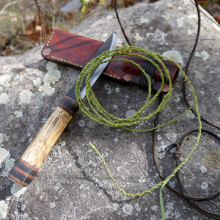Article
The person chosen during the Enemyway ceremonial to collect and carry a symbolic enemy scalp to the place where it will be shot and ritually defeated. The object representing the enemy scalp is tied to a pole with yucca fibers and is not touched by the naked hand. Not to be confused with the scalp shooter, the scalp carrier must not pass his burden to any other person, and he must travel unaccompanied.
In curing ceremonials, such as the Navajo Enemyway, the scalp referenced is a token object representing an enemy. The Enemyway is a ceremony performed to cure people from illness caused by coming into contact with an "enemy," typically someone or an experience outside the Navajo culture and traditional lifeways. The symbolic scalp is collected during a ritualized warpath prior to the ceremony, brought to the place of healing without being touched, and kept out of sight until it is time to be destroyed.
"Twisted Yucca Fibers" by dog.breath is licensed under CC BY-NC-ND.
Manuscripts
References
Frisbie, Charlotte Johnson
1980 Approach to the Ethnography of Navajo Ceremonial Performance. Ethnography of
Musical Performance, Norma Mcleod and Marcia Herndon, eds. Norwood: Norwood
Editions.
Haile, Berard
1938 Origin Legend of the Navaho Enemyway. New Haven: Yale University Press.
Hirschfelder, Arlene, and Paulette Molin
2000 Evil Way. Encyclopedia of Native American Religions, Updated Edition. New York:
Facts On File, Inc.
Wyman Leland
1983 Navajo Ceremonial System. In Handbook of North American Indians, Vol. 10.. A.
Ortiz, ed. Pp. 536-537. Washington: Smithsonian Institution.

